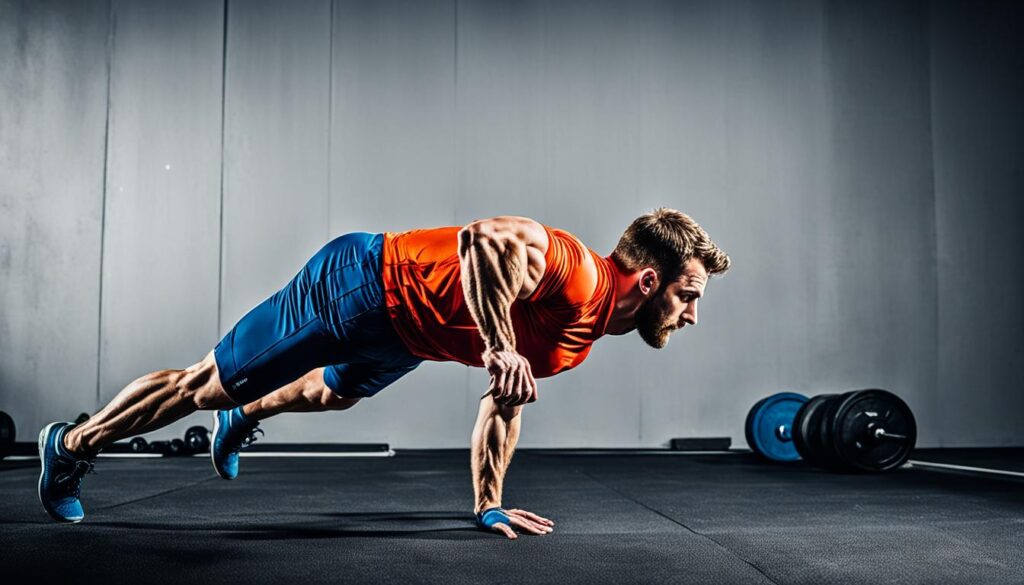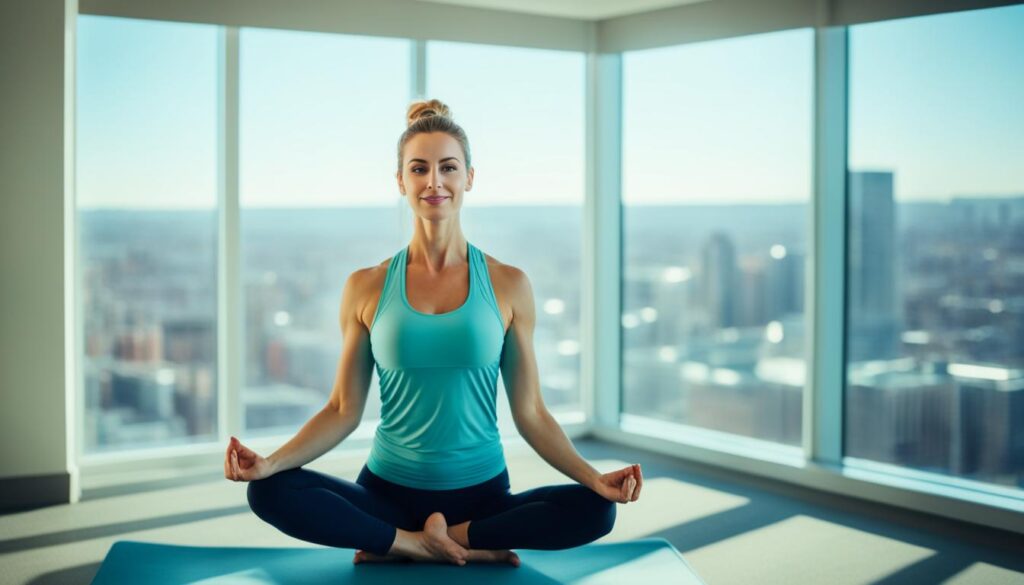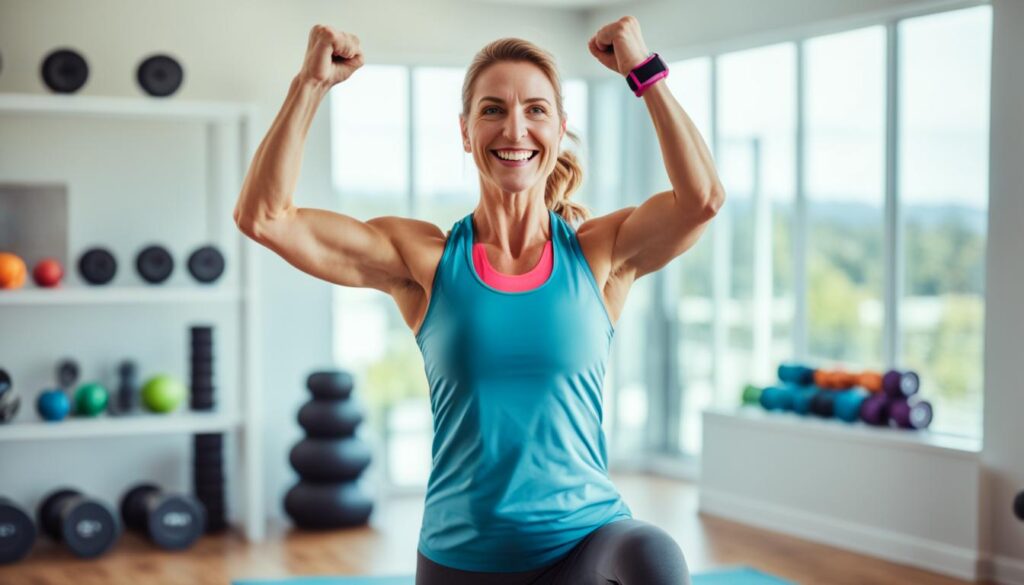Discover effective and versatile workout routines that you can do at home, regardless of your fitness level. Whether you’re a beginner, intermediate, or advanced exerciser, this article provides customizable exercises and programs that require no gym equipment. Learn how to get in shape and reach your fitness goals through structured, easy-to-follow at-home workouts.
Key Takeaways
- Discover effective at-home workout routines for all fitness levels
- Learn to achieve your fitness goals with no-equipment exercises
- Explore customizable programs and workouts you can do at home
- Improve cardiovascular health and achieve fat loss through periodization1
- Consistency and a support system are key to maintaining a workout routine1
Introduction
As the world has adapted to new norms, at-home workouts have become increasingly vital for maintaining fitness and overall well-being. These convenient, cost-effective exercise routines offer a range of benefits that cater to individuals of all fitness levels, from beginners to advanced fitness enthusiasts.
Benefits of Exercise for All Fitness Levels
Regular exercise, regardless of your starting point, can have a transformative impact on your physical and mental health. At-home workouts can improve cardiovascular health, build strength and muscle, boost mood and energy levels, and support overall well-being2.
Strength training, in particular, is crucial for improving bone density, flexibility, balance, and metabolism, ultimately helping to prevent injuries and burn more calories2. Incorporating a mix of cardiovascular and muscle-building exercises, such as walking, squats, and bicep curls, can provide a well-rounded approach to fitness that caters to various needs and abilities2.
Notably, the benefits of at-home workouts extend beyond weight loss, as they can lead to “non-scale victories” (NSVs), such as increased energy, improved mood, better-fitting clothes, and lifestyle changes like cooking at home instead of ordering takeout2.
“Regular exercise, regardless of your starting point, can have a transformative impact on your physical and mental health.”
The versatility of at-home workouts allows for easy modifications to accommodate individual needs, such as using household items as weights or adjusting exercises to alleviate any discomfort2. This adaptability ensures that individuals of all fitness levels can engage in effective, safe, and enjoyable exercise routines from the comfort of their own homes.
By incorporating at-home workouts into their lifestyles, people can prioritize their health and well-being without the constraints of traditional gym memberships or limited access to fitness facilities. The importance of home exercise has become increasingly evident, empowering individuals to take control of their fitness journey and reap the numerous benefits it offers2.
Equipment-Free Beginner Bodyweight Routine
For those new to working out at home, this beginner bodyweight routine requires no equipment and can be done in a small space3. The workout routine should be done 2-4 times a week with 48 hours off between workouts3. Bodywweight training can be effective for weight loss if combined with a proper nutrition plan3.
Warm-Up Exercises
Start with a brief warm-up to activate your muscles and prepare your body for the main workout. This can include exercises like jumping jacks, high knees, and arm circles3.
Core Exercises: Bridges, Squats, and Planks
After the warm-up, move into core-strengthening exercises like bridges, squats, and planks. These foundational movements will help build a solid fitness base and prepare your body for more advanced exercises3. Complete 2 sets of 10-15 reps of each exercise, resting for 30-60 seconds between moves.
- Bridges: Lie on your back with your knees bent and feet flat on the floor. Lift your hips off the ground, forming a straight line from your knees to your shoulders. Hold for a few seconds, then lower back down4.
- Squats: Stand with your feet shoulder-width apart, toes slightly turned out. Bend your knees and hips to lower your butt back and down, keeping your chest up. Press through your heels to return to the starting position4.
- Planks: Start in a push-up position, with your hands directly under your shoulders and your body in a straight line from head to heels. Hold this position, engaging your core, for 15-30 seconds4.
“Exercise frequency pattern recommended: Strength training on one day, followed by activities like walking, hiking, or yoga the next day, and then back to strength training.”3
After completing the Beginner Bodyweight Workout for 4-6 weeks, individuals are advised to focus on progress by aiming to do more reps or exercises than in the previous sessions345.
Intermediate Bodyweight Exercises
Once you’ve mastered the beginner bodyweight routine, it’s time to progress to more challenging intermediate bodyweight exercises. This sequence includes moves like single-leg bridges, standard pushups, walking lunges, and pike pushups6. Aim for 2 sets of 10-15 reps per exercise, with 1 minute of rest between rounds. Alternatively, you can try a timed circuit, completing 1 minute of each exercise and repeating the full sequence twice6.
The intermediate bodyweight workout is designed to provide a step-up in difficulty from the beginner level, helping you continue to build strength and endurance. By incorporating these progressive home exercises, you’ll challenge your muscles in new ways and see continued improvement in your overall fitness level6.
| Exercise | Reps | Sets |
|---|---|---|
| Single-Leg Bridge | 10-15 per leg | 2 |
| Standard Pushup | 10-15 | 2 |
| Walking Lunge | 10-15 per leg | 2 |
| Pike Pushup | 10-15 | 2 |
Remember, the key to progression is to continually challenge yourself. As you become more comfortable with these intermediate bodyweight exercises, consider adding weight, increasing reps, or trying more advanced variations to keep your workouts engaging and effective6.
“Consistency is key when it comes to any fitness routine, whether it’s beginner or advanced. Keep showing up, and you’ll be amazed at the progress you can make with progressive home exercises.”
Advanced Bodyweight Workout
For those seeking a truly intense at-home workout, this advanced bodyweight routine features exercises that require significant strength and stability7. Movements like one-legged squats, pull-ups, and dips will push your muscles to the limit. Complete 3 circuits of this sequence, resting for 1 minute between rounds. Be sure to master the proper form on these challenging moves to avoid injury and get the most benefit from your workout7.
Challenging Moves: One-Legged Squats, Pull-Ups, and Dips
The Bodyweight Standard program suggests specific requirements for a solid level of bodyweight strength, including 25 “Ass to Grass” Bodyweight Squats, 5 Chest-to-Bar Pull Ups, 25 Chest-to-Deck Push-Ups, and others7. Emphasis is placed on progressing to more difficult bodyweight exercises over time to enhance strength, with examples including explosive movements and advanced variations like single-arm push-ups and pistol squats7.
High volume bodyweight training involves performing extremely high numbers of movements, such as three sets of 100 push-ups or five sets of 20 pull-ups8. Continuous time under tension during high-rep bodyweight training aims to enhance work capacity, improve metabolic stress for muscle growth, and increase blood supply by creating new capillaries8. Pushing to failure in bodyweight training can help build strength by increasing motor unit recruitment, challenging neural drive, and improving the mind-muscle connection8.
In a study by Kennesaw State University, a 20-minute CrossFit bodyweight AMRAP was found to provide a ‘greater training stimulus’ compared to running on a treadmill at 85% of maximal heart rate for the same duration9. Research published in Physiology & Behavior has shown that muscle growth can occur independently of an external load with bodyweight exercises, as long as exercises are performed through their full range of motion9.
Advice is given to avoid training to failure mostly, emphasizing the importance of being fast and efficient with movements for optimal strength gains7. The Bodyweight Gauntlet, designed to test bodyweight conditioning and strength levels, features four essential movements: Push-Ups, Strict Pull-Ups, Squats, and Burpees, to be performed in an all-out, three-minute set each7.

Remember, the duration of an effective bodyweight workout program for strength and conditioning is aimed at 30-40 minutes, to be done 3 times a week7. Incorporate these advanced bodyweight exercises into your routine to take your at-home strength training to the next level.
Circuit Training for Efficient Home Workouts
When it comes to maximizing your workout time at home, circuit training is an excellent approach. Circuit training, where you move quickly between a series of exercises with little to no rest, is an effective way to get a full-body workout in a relatively short amount of time10. This style of training keeps your heart rate elevated, burning calories and building strength and endurance10.
A typical circuit training workout involves cycling through 5 to 10 stations, each targeting different muscle groups or cardio exercises10. You’ll complete each exercise for 1 minute before moving on to the next, repeating the circuit 4 times for a 45-minute workout10. This efficient training method may also help increase your VO2 max, the amount of oxygen your body can consume at a given time10.
Circuit training is a versatile and customizable approach that’s suitable for all fitness levels10. It allows you to work on both cardio and strength training simultaneously, making it an excellent way to burn fat and build muscle10. Even a 15-minute circuit can be structured with exercises like squats, triceps dips, reverse lunges, sit-ups, and cardio bursts like high knees and burpees10.
The benefits of circuit training include combating boredom during workouts and being able to do it anywhere with minimal equipment10. Whether you’re a beginner or an advanced exerciser, circuit training offers endless ways to vary and tailor your workouts to your individual needs and fitness level10.
Compared to an equivalent amount of cardio, circuit training has been shown to be more effective at building strength and burning fat for individuals with limited time11. Strength training circuits are great for weight loss and overall health, as the increased calorie burn from rebuilding muscles can aid in weight loss11.
When designing a circuit training workout, you can incorporate a variety of exercises and equipment, such as bodyweight moves, dumbbells, kettlebells, and resistance bands11. The key is to keep the intensity high and transition quickly between exercises to maintain an elevated heart rate throughout the workout10.
Whether you’re looking to maximize your workout time, challenge yourself with new exercises, or simply add some variety to your routine, circuit training is an efficient and effective way to get a great workout at home10. By combining cardio and strength training in a circuit format, you can achieve your fitness goals and make the most of your limited workout time101112.
Themed Workout Routines: Star Wars, Parkour, and Batman
To add a touch of fun and excitement to your at-home workouts, try these themed routines inspired by popular franchises like Star Wars, Parkour, and Batman. Each sequence features a variety of bodyweight exercises that can be performed in a small space, with progressions to challenge fitness levels. Whether you’re a fan of these beloved franchises or simply looking for a new way to spice up your home training, these entertaining and effective workouts are sure to keep you motivated13.
The Star Wars-inspired routine draws inspiration from the skills and physiques of characters like Star-Lord, who stands at 6’2″ and weighs 175 lbs, putting him in the average height and weight range for male characters14. The workout focuses on building muscular and toned aesthetics, as well as improving martial arts abilities, strength, and speed. It incorporates a hybrid training system with big lifts, core work, and calisthenics, along with a recurring “Peter Quill Circuit Test” for progress tracking14.
For those seeking a more athletic and agile approach, the Parkour-inspired routine takes inspiration from the real-world ninja training of the past13. This workout emphasizes strategic terrain navigation, surprise elements, and deception tactics to overcome larger opponents, just like the historical ninjas. Exercises may include scaling buildings, using rope ladders between rooftops, and creating distractions by imitating wildlife sounds13.
Finally, the Batman-inspired routine challenges you to channel your inner Caped Crusader. Drawing from the physiques and abilities of various comic book characters, this workout routine caters to a wide range of heights and weights, from the shorter Wolverine and Vegeta at 5’3″ to the towering Ronan and Sagat at 7’5″15. Whether you’re aiming for the sleek and muscular look of Nightwing or the sheer power of Bane, this routine offers a well-rounded challenge that combines strength, agility, and endurance15.
Embrace your inner superhero or villain with these themed workout routines, and take your at-home training to new heights of excitement and effectiveness131415.
HIIT Workout Routines for at Home
High-Intensity Interval Training (HIIT) workouts are the perfect solution for time-efficient, calorie-burning exercise routines that can be done right in the comfort of your own home. These workouts involve alternating periods of intense effort with brief recovery periods, keeping your heart rate elevated and maximizing the benefits in a short amount of time16. Many HIIT workouts, such as the Angry Birds Workout and burpee-based routines, can be completed using only your bodyweight and a small amount of space16.
HIIT workouts have been shown to improve metabolism, muscle building, fat burning, energy, and cardiovascular endurance16. They also create an “after-burn effect,” leading to increased calorie burn even after the workout is finished16. Best of all, no equipment is needed for these effective at-home HIIT workout routines16.
These workouts often involve a combination of strength training and cardio exercises, such as squats, jumping jacks, and grapevines16. It’s recommended to do HIIT workouts every other day, with 30 minutes of steady-state cardio like walking, biking, or swimming on the off days16. Low-impact modifications are also provided for the high-intensity exercises to cater to different fitness levels16.
The provided HIIT workout routines range from 10 to 30 minutes in duration and may require equipment like dumbbells, resistance bands, medicine balls, and mats17. These workouts are designed by various trainers and fitness professionals, offering a blend of strength, cardio, and total body exercises17. Specific exercise formats like Tabata are included, with repetition rounds varying from 3 to 5 per exercise17. Some routines even incorporate the AMRAP (as many reps as possible) format and prescribed work-rest intervals17.
When starting HIIT workouts at home, it’s recommended to begin with one to two sessions per week on non-consecutive days18. A common suggested work-to-rest interval is one minute of work with a 30-second rest, repeated for four rounds18. Beginners should choose five exercises for their HIIT routine, with a mix of upper body, lower body, core, and cardio movements, doubling up on cardio-focused exercises18. Active recovery days following HIIT workouts are crucial to allow the body to recuperate and manage muscle soreness18.
HIIT workouts are highly effective, providing a greater cumulative impact compared to lower-intensity exercises with the same time investment18. By incorporating these dynamic, equipment-free routines into your home fitness regimen, you can achieve impressive results in a fraction of the time161718.
Hotel Room Workout Routines
Staying active while traveling can be a challenge, but this 20-minute hotel room workout provides an effective solution19. Using only your bodyweight and basic hotel furniture, you can target all major muscle groups with exercises like bodyweight squats, incline push-ups, and reverse crunches19. Both beginner and intermediate versions of this routine are provided, allowing you to customize the workout based on your fitness level, even when you’re away from home19.
The Hotel Room Workout is split into three levels for different fitness levels: beginners (Level 1), intermediate (Level 2), and advanced (Level 3)19. Level 1 workout includes 4 exercises with 20 reps of Bodyweight Squats, 15 reps of Incline Push-Ups, 10 reps of One-Arm Luggage Rows, and 10 reps of Reverse Crunches19. Level 2 workout consists of 25 reps of Overhead Squats, 20 Push-Ups, 10 Inverted Rows, and 15 Reverse Crunches19. Level 3 workout comprises 25 Jumping Squats, 20 Decline Push-Ups, 10 Inverted Bodyweight Rows, and 15 Reverse Crunches19.
The hotel room workout emphasizes full-body routines targeting legs, push (chest, shoulders, triceps), pull (back, biceps, forearms), and core (abs and lower back)19. A 15-minute time frame is suggested for completing the workout circuits19. This travel-friendly exercise routine highlights the importance of exercising in a hotel room for maintaining fitness and supporting healthier dietary choices while on the road19.
For those seeking a quick no-equipment hotel workout, a list of 10 exercises can be easily incorporated into a hotel room routine19. The list includes Push-ups, Bodyweight Squats, Lunges, Single-Arm Rows, Inverted Bodyweight Row, Plank, Reverse Crunch, Hip Raises, Burpees (advanced), and Wall Walks (advanced)19. These hotel room workouts are designed to be efficient and effective, allowing travelers to stay fit even when they’re away from home19.
“Adding just 10 minutes per day of physical activity is estimated to prevent over 111,000 deaths per year.”20
The hotel room workouts provided in the material range from 10 to 30 minutes in duration, emphasizing efficiency in a small space without the need for equipment20. These travel-friendly exercise routines can be a valuable tool for maintaining fitness and supporting healthier choices while on the road20.
| Workout Level | Exercises | Reps |
|---|---|---|
| Level 1 (Beginner) |
|
|
| Level 2 (Intermediate) |
|
|
| Level 3 (Advanced) |
|
|

For those seeking a quick no-equipment hotel workout, the material suggests a circuit workout that can be done in a hotel room without additional equipment21. The recommended exercises include bodyweight squats, push-ups, jumping jacks, suitcase squats, triceps dips, and mountain climbers21. Resistance bands are also highlighted as a compact and versatile tool that can be used to intensify hotel room workouts21.
Whether you’re a beginner, intermediate, or advanced exerciser, these hotel room workout routines provide a convenient and effective solution for staying active while traveling19. By incorporating these travel-friendly exercise routines into your hotel stays, you can maintain your fitness goals and support healthier choices on the go192021.
workout routines for at home
The at-home workout routines featured in this article are designed to be versatile and customizable to a wide range of fitness levels. Whether you’re a beginner just starting your fitness journey or an advanced exerciser looking to challenge yourself, you can find workout plans that can be scaled up or down to meet your current abilities22. This ensures that you can continue to progress and see results from your home-based training over time.
Beginner Bodyweight Routines
The beginner routine consists of 10 bodyweight exercises suitable for those new to exercise, involving 2 sets of 10 to 15 reps for each exercise, with 30 seconds to 1 minute of rest between movements22. These foundational exercises, such as bridges, squats, and planks, help build strength and endurance while ensuring proper form and technique.
Intermediate Bodyweight Workouts
As you progress, the intermediate routine includes more challenging exercises than the beginner level, suggesting performing 2 sets of 10 to 15 reps for each exercise with 1 minute of rest between moves22. Alternatively, you can complete timed rounds of 1 minute for each exercise and repeat the circuit twice. This approach helps build muscular endurance and coordination.
Advanced Bodyweight Challenges
For those who have mastered the beginner and intermediate routines, an advanced approach is recommended to push the limits of your fitness levels22. The advanced routine focuses on increasing the intensity of the workout by incorporating more difficult variations of exercises such as single-leg bridge, standard pushup, walking lunge, pike pushups, get-up squats, superman, plank with alternating leg lift, kneeling side plank with hip abduction, and dead bug22. This advanced routine promotes progress by encouraging participants to compete against themselves to achieve 1 or 2 more reps each time they perform the routine, fostering growth in strength and endurance over time22.
By offering a range of versatile home workouts, customizable at-home exercise routines, and workout plans for all levels, this article provides the guidance and resources you need to achieve your fitness goals from the comfort of your own home222324.
Strength Training Programs for Home
In addition to the bodyweight-focused routines covered earlier, there are several well-known strength training programs that can be done entirely at home. One of the most popular is P90X, a challenging 90-day program developed by Tony Horton that incorporates resistance training, cardio, and yoga using minimal equipment25.
Other popular home workout programs, such as Beachbody’s 80-Day Obsession, also provide structured plans to build muscle and improve overall fitness without the need for a gym membership25. These programs are designed to help individuals achieve their fitness goals through a combination of strength training, high-intensity interval training (HIIT), and flexibility exercises, all within the comfort of their own homes.
P90X and Other Popular Home Workout Programs
The P90X program, for example, is known for its challenging resistance training routines that target all major muscle groups. It utilizes a variety of equipment, including resistance bands, dumbbells, and bodyweight exercises, to provide a comprehensive strength-building experience25. Similarly, the Caliber App is recognized as the Best Online Workout Program for Strength Training, offering scientifically-based training plans for increasing strength and improving body composition, with a premium version priced around $200 per month25.
Another popular home workout program, iFIT, is the Best Online Workout Program for Motivation, providing immersive training experiences, world-class coaches, and a vast library of workouts. However, it was noted to be pricier for some users25.
Regardless of the specific program, these home-based strength training options offer a convenient and effective way for individuals to build muscle, increase strength, and improve their overall fitness without the need for a gym membership25. The key is to find a program that aligns with your fitness goals, personal preferences, and budget, and to commit to a consistent routine to see the best results.

“Strength training can help reduce body fat, burn calories more efficiently, and increase bone density.”26
Research shows that strength training can provide a range of benefits beyond just building muscle26. Incorporating resistance exercises into your at-home workout routine can help you burn more calories, improve your body composition, and even enhance bone density26.
Whether you choose to follow a structured program like P90X or prefer to create your own strength-focused routine, the key is to focus on progressive overload and challenging your muscles27. This can be achieved through a variety of methods, such as using bodyweight exercises, resistance bands, dumbbells, or even a single kettlebell27.
The most effective home strength training program is the one that you can consistently adhere to, so it’s important to find an approach that aligns with your fitness level, available equipment, and personal preferences27. By incorporating strength training into your at-home workouts, you can unlock a wide range of health and fitness benefits, all from the comfort of your own living space252627.
Yoga and Flexibility Routines
While strength and cardio-focused workouts are crucial components of an at-home fitness regimen, it’s essential not to overlook the benefits of yoga and flexibility training. Incorporating yoga poses and mobility exercises into your home routine can improve balance, range of motion, and overall body awareness28. These types of low-impact activities can be done in a small space and require minimal, if any, equipment, making them an accessible way to complement your strength and cardiovascular training.
Yoga has been shown to boost flexibility, helping individuals move their joints with less effort and leading to a greater range of motion28. Practicing yoga regularly can also help release muscle tension, reducing tightness and making movement easier28. Improved flexibility through yoga can contribute to better posture, reducing the risk of muscle strain and poor posture28. Furthermore, yoga can aid in reducing stress levels by releasing tension in the muscles, promoting relaxation and decreasing stress28. Individuals with greater strength and flexibility in muscles and joints are less prone to injuries28.
Practicing yoga poses can facilitate better circulation, allowing for faster muscle recovery after workouts and reducing stiffness28. Various yoga poses, such as Intense side stretch (Parsvottanasana) and Head to knee (Janu Sirsasana), can significantly enhance back flexibility28. Poses focusing on core flexibility, like Cat-Cow (Bitilasana Marjaryasana) and Bow Pose (Dhanurasana), are beneficial for improving mobility in the core, neck, shoulders, and spine28. Yoga poses that target hip flexibility, such as Low lunge (Anjaneyasana) and Wide-angle seated forward bend (Upavistha Konasana), help lengthen the spine, open the hips, and strengthen muscles, potentially easing sciatica28. Shoulder and neck flexibility can be enhanced through poses like Cow Face Pose (Gomukhasana) and Plow Pose (Halasana), which stretch the shoulders, chest, arms, and alleviate tension in the neck and spine28.
Safety is emphasized in yoga practice, cautioning against forcing poses, advising to listen to the body, and recommending consulting with a healthcare provider before starting yoga, especially for those with health conditions or taking certain medications28.
| Yoga Benefits | Details |
|---|---|
| Improved Flexibility | Yoga helps release muscle tension, reduce tightness, and enhance range of motion in various body parts, including the back, core, hips, and shoulders28. |
| Enhanced Strength and Stability | Yoga poses engage major muscle groups, build muscle, strengthen bones and ligaments, improve core stability, balance, and overall stability29. |
| Stress Reduction | Yoga can aid in reducing stress levels by releasing muscle tension, promoting relaxation, and decreasing stress28. |
| Injury Prevention | Individuals with greater strength and flexibility in muscles and joints are less prone to injuries28. |
| Improved Circulation and Recovery | Practicing yoga poses can facilitate better circulation, allowing for faster muscle recovery after workouts and reducing stiffness28. |
In addition to the physical benefits, yoga can also contribute to overall well-being. Peloton instructor Ross Rayburn practices yoga six times a, incorporating therapeutic sessions, colleagues’ classes, and vigorous yoga practices30. The National Institute on Aging’s research highlights the importance of alternating between workouts covering endurance, strength, balance, and flexibility30. Chelsea Jackson Roberts, another Peloton instructor, recommends integrating cardio through classes, daily brisk walks, and hiking to complement yoga practice30.
A 30-minute yoga routine can help boost flexibility, strengthen the core, and stretch muscles29. This routine is suitable for both beginners and advanced yogis, with a focus on breathing exercises to improve anxiety, stress, and mind-body awareness29. The yoga poses target mobile shoulders and hips, as well as stretch muscle groups like hamstrings, back, chest, and shoulders29. Consistent yoga practice, even once a week, can provide long-term benefits, though developing flexibility takes time29.
In conclusion, incorporating yoga and flexibility routines into your at-home fitness regimen can provide a wealth of benefits, from improved mobility and balance to reduced stress and injury prevention. By exploring a variety of yoga poses and integrating these low-impact activities into your workout routine, you can enhance your overall well-being and complement your strength and cardiovascular training283029.
Nutrition and Recovery for At-Home Workouts
To get the most out of your at-home workout routine, focusing on proper nutrition and recovery strategies is crucial. Consuming a balanced diet with adequate protein, carbohydrates, and healthy fats can provide the energy and building blocks your body needs to adapt and improve from your home training31. Additionally, practices like hydration, foam rolling, and active recovery can help reduce muscle soreness and support your body’s ability to recover between workouts, allowing you to train consistently and progress over time32.
When it comes to fueling your at-home workouts, the key is to emphasize nutrient-dense, whole foods that will provide sustained energy and support muscle repair. Opt for lean protein sources like chicken, fish, eggs, or plant-based options such as lentils, tofu, or quinoa. Pair these with complex carbohydrates like whole-grain breads, oats, or sweet potatoes to replenish glycogen stores. Healthy fats from avocados, nuts, seeds, or olive oil can also help with workout recovery and hormone production33.
Proper hydration is also essential for optimizing your at-home workouts. Aim to drink water consistently throughout the day, and increase your intake before, during, and after your training sessions to replace fluids lost through sweat33.
In addition to your nutrition strategy, incorporating recovery practices like foam rolling, stretching, and active rest can help minimize muscle soreness and prepare your body for the next workout32. Taking the time to listen to your body and allow for adequate rest and recovery can ultimately help you train harder, avoid injury, and make consistent progress in your at-home fitness journey33.
“Proper nutrition and recovery are just as important as the workout itself when it comes to achieving your fitness goals.”
By focusing on nutrition for home workouts, recovery strategies, and workout fuel, you can unlock the full potential of your at-home fitness routine and continue to see progress in the comfort of your own space. Remember, consistency, patience, and a holistic approach to your health and wellness are key to long-term success.
Conclusion
In this comprehensive guide, we’ve provided a wide array of effective, customizable workout routines that can be performed in the comfort of your own home. Whether you’re a beginner, intermediate, or advanced exerciser, you now have the tools and knowledge to create a structured, challenging fitness program using only your bodyweight and minimal equipment34. By incorporating these at-home workouts into your lifestyle, you can improve your strength34, cardiovascular health, and overall well-being without the need for a gym membership.
As you continue your fitness journey, remember to experiment, track your progress, and adapt the routines to keep your workouts fresh and engaging35. Utilizing fitness tracking apps, setting reminders, and encouraging colleagues to join in can help maintain motivation and consistency with your at-home exercise routine35. Ultimately, the benefits of home exercise, such as35 mood improvement, increased brain activity, and stress management, will continue to support your overall health and wellness.
Stay committed to your fitness goals, and remember that small, incremental steps can lead to significant progress over time34. By integrating these at-home workout routines into your daily life, you are taking a proactive approach to maintaining a healthy and active lifestyle, even in the comfort of your own space. Here’s to your continued fitness success!
FAQ
What are the benefits of at-home workouts?
At-home workouts offer numerous benefits, including convenience, cost-effectiveness, and the ability to customize routines to your specific needs and fitness level. Regular exercise, regardless of your starting point, can improve cardiovascular health, build strength and muscle, boost mood and energy levels, and support overall well-being.
What are some effective beginner bodyweight exercises I can do at home?
The beginner bodyweight routine includes a warm-up and core-strengthening exercises like bridges, squats, and planks. These foundational movements will help build a solid fitness base and prepare your body for more advanced exercises.
How can I progress from beginner to intermediate and advanced home workouts?
The article provides guidance on intermediate exercises like single-leg bridges, pushups, and walking lunges, as well as advanced moves such as one-legged squats, pull-ups, and dips. By mastering the proper form, you can gradually increase the difficulty of your home workouts over time.
What are the benefits of circuit training for at-home workouts?
Circuit training, where you move quickly between a series of exercises with little to no rest, is an excellent way to get an effective workout at home. This style of training keeps your heart rate elevated, burns calories, and builds strength and endurance in a relatively short amount of time.
Can I find themed workout routines to make my at-home training more engaging?
Yes, the article features themed routines inspired by popular franchises like Star Wars, Parkour, and Batman. These sequences provide an entertaining and effective home training experience, with progressions to suit different fitness levels.
How can I incorporate HIIT workouts into my at-home fitness routine?
High-Intensity Interval Training (HIIT) is an excellent option for efficient, calorie-burning workouts that can be done right at home. These routines involve periods of intense exercise followed by brief recovery periods, keeping your heart rate elevated and maximizing the benefits in a short amount of time.
What kind of at-home workout routines can I do while traveling?
The article provides a 20-minute hotel room workout that uses only your bodyweight and basic hotel furniture to target all major muscle groups. Both beginner and intermediate versions of this routine are provided, allowing you to customize the workout based on your fitness level, even when you’re away from home.
How can I make my at-home workouts more versatile and adaptable?
The at-home workout routines featured in this article are designed to be versatile and adaptable to a wide range of fitness levels. Whether you’re a beginner or an advanced exerciser, you can find workout plans that can be scaled up or down to meet your current abilities, allowing you to continue progressing over time.
What other types of home workout programs are available besides bodyweight exercises?
In addition to the bodyweight-focused routines, there are several well-known strength training programs, such as P90X and Beachbody’s 80-Day Obsession, that can be done entirely at home using minimal equipment.
How important is it to focus on nutrition and recovery for at-home workouts?
Proper nutrition and recovery practices are crucial for getting the most out of your at-home workouts. Consuming a balanced diet with adequate macronutrients, staying hydrated, and incorporating recovery activities like foam rolling can help reduce muscle soreness and support your body’s ability to adapt and improve from your home training.
Source Links
- How to Create a Home Workout Routine You’ll Actually Stick With
- A 31-day strength-training workout to add to your walking routine
- Bodyweight Workout for Beginners (20-Minute at Home Routine)
- A 30-day strength training routine — no equipment required
- Advanced Bodyweight Workout Circuit (Full Body Routine)
- Bodyweight Workouts & Exercises to Get You Ripped | Onnit Academy
- Advanced Bodyweight Training for Size and Performance – The Bioneer
- 31 Bodyweight Exercises to Pack on Muscle at Home
- You Can Burn Major Calories At Home With These Three Circuit Workouts
- 15 Circuit Training Workouts (Train FAST in the Home or Gym)
- The Ultimate Full-Body Circuit Workout to Do at Home
- Real Ninja Training
- Star-Lord Workout: Train like Shredded Peter Quill!
- Darth Maul Workout Routine: Train like The Star Wars Sith Lord
- 15 HIIT exercises you can do at home to torch calories and build muscle
- HIIT Training Can Get You Results Faster Than Running On A Treadmill
- 22 HIIT Exercises So You Can Create Your Own Sweaty Routine
- The 20-Minute Hotel Room Workout: 10 Quick Exercises | Nerd Fitness
- Best Hotel Room Workouts: Stay Fit While Traveling | Garage Gym Reviews
- Traveling? Try This Hotel Room Workout
- The Ultimate Home Workout for Each Fitness Level
- The 10 Best at Home Workouts (No-Equipment!) | Nerd Fitness
- At Home
- 8 Best Online Workout Programs of 2024 | Garage Gym Reviews
- Strength Training at Home: Workouts With and Without Equipment
- 5 Strength Training Workouts (for Beginners) | Nerd Fitness
- Yoga for Flexibility: 8 Poses for Your Back, Core, Hips, Shoulders
- Forget weights — this 30-minute yoga routine builds flexibility and strengthens your core
- How to Create a Yoga-Focused Workout Routine at Any Fitness Level
- Workout Routines for Men: The Ultimate Guide
- This 7-Day Workout Routine Has It All
- How to Start Exercising: A Beginner’s Guide to Working Out
- Home Workouts: More Effective Than the Gym?
- 10 Work From Home Exercises For Staying Active


